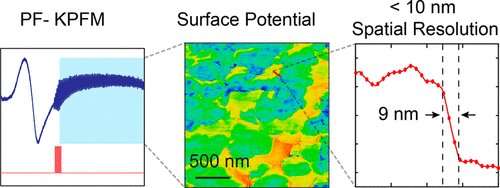#New microscopy under ambient achieves less than 10 nm spatial resolution on surface potential measurement
“#New microscopy under ambient achieves less than 10 nm spatial resolution on surface potential measurement”

A new nanomaterials microscopy approach called Pulsed Force Kelvin Probe Force Microscopy (PF-KPFM), allows for less than 10 nanometer measurements of work function and surface potential in a single-pass AFM scan. The findings have been published in two related articles in ACS Nano and Angewandte Chemie International Edition.
As technology shrinks, the need to characterize the properties of very small materials—measured in nanometers (1 nanometer = 1 billionth of a meter)—has become increasingly important. Nanomaterials that measure from 1 and 20 nanometers show promise for use in next-generation electronic devices, solar cells, laser technology, and chemical and biosensors, to name a few. For scale, the width of a human hair is 75,000 nanometers.
To understand the surface potential of nanomaterials, the most commonly used nanoscience tool is the Kelvin Probe Force Microscopy (KPFM), which is an atomic force microscopy (AFM) based technique that measures work function and surface potential. Unfortunately, KPFM has its limitations due to its use of AC voltage to charge the AFM probe.
“Every KPFM technique operates on the same measurement paradigm: AC voltage is used to completely charge an AFM probe, thus producing a detectable electrostatic force for image acquisition,” explains Xiaoji Xu, assistant professor in Lehigh University’s Department of Chemistry. “Overloading the probe with charges forces a limit on the spatial resolution, since the charges are not limited to the apex of the AFM probe. Instead, excess charges occupy the entire cantilever and contribute to the signal.”
Now, Xu and his graduate student Devon S. Jakob have introduced an entirely new measurement paradigm based on the alignment on Fermi levels. While traditional KPFM methods produce images with a spatial resolution of 30 to 100 nanometers, the new Xu Research Group method, called Pulsed Force Kelvin Probe Force Microscopy (PF-KPFM), allows for less than 10 nanometer measurements of work function and surface potential in a single-pass AFM scan. Their findings have been published in an article in ACS Nano: “Pulsed Force Kelvin Probe Force Microscopy.”
“In Pulsed Force Kelvin Probe Force Microscopy, we removed the need for the AC voltage by implementing a custom circuit of a field effect transistor between the tip and the sample which acts as a binary switch,” says Xu. “When the switch is on, the circuit acts as a simple wire, allowing charges to pass between tip and sample. A small amount of charges spontaneously migrates between tip and sample based on the relative difference in their intrinsic Fermi levels. When the switch is off, the circuit does not allow for charges to pass, and acts as a capacitor to re-absorb the charges from the tip and sample region.”
The PF-KPFM also exclusively operates in the pulsed force mode, according to Xu. By using the pulsed force mode, he says, PF-KPFM measurements can be accurately obtained at very small tip-sample distances, where the electrical force is large, allowing for small sample heterogeneities to be revealed.
“The next logical step was to combine PF-KPFM with Peak Force Infrared (PFIR) microscopy, an infrared imaging technique invented in our lab, since both techniques use the pulsed force mode,” says Xu. “The resulting technique, named PFIR-KPFM, provides topographical, mechanical, chemical, and electrical information at
So, in addition to achieving significant improvements in measuring electrical potential in nanomaterials in a single-pass AFM scan, PF-KPFM can be combined with (PFIR) microscopy for high-throughput correlative measurements, according to the researchers. This follow-up study is described in an article, “Peak Force Infrared ? Kelvin Probe Force Microscopy,” forthcoming in Angewandte Chemie International Edition.
“Pulsed force KPFM is the first KPFM technique to truly implement the pulsed force mode of AFM for nanoscale surface potential characterization, and the first KPFM technique to be combined with simultaneous infrared detection in the same scan,” says Xu.
The importance of accurately measuring the nanoelectrical properties of materials is far-reaching in both academia and industry, according to the researchers. Due to the increasingly smaller size of semiconductor devices, PF-KPFM may be especially helpful for technology companies, as the high spatial resolution of PF-KPFM reveals features that are too small for other KPFM techniques. Similarly, they say, PFIR-KPFM will be beneficial in revealing the correlations between chemical heterogeneity, structure, and electrical properties of lab-made solar cell components.
“Ultimately,” says Xu, “we hope that our invention will open the door for characterization of new materials, and help pave the way for more efficient energy-related devices.”
Xu’s research group develops new methods and instruments for chemical measurement and imaging at the nanoscale with spatial resolution. They employ two infrared nanoscale imaging methods invented by Xu: peak force scattering-type near-field optical microscopy (PF-SNOM) and peak force infrared (PFIR) microscopy. These techniques empower researchers to study previously inaccessible nanoscale objects with multimodal spectroscopic information close to the lower limit of spatial scale.
Xu was named a 2020 Sloan Research Fellow. This prestigious award, funded by the Alfred P. Sloan Foundation, places Xu among “the most promising scientific researchers working today.” Additionally, was named a Beckman Young Investigator, earning a prestigious grant awarded by the Arnold and Mabel Beckman Foundation for “the most promising young faculty members in the early stages of their academic careers in the chemical and life sciences.”
More information:
Devon S. Jakob et al, Peak Force Infrared – Kelvin Probe Force Microscopy, Angewandte Chemie International Edition (2020). DOI: 10.1002/anie.202004211
Devon S. Jakob et al. Pulsed Force Kelvin Probe Force Microscopy, ACS Nano (2020). DOI: 10.1021/acsnano.0c00767
New microscopy under ambient achieves less than 10 nm spatial resolution on surface potential measurement (2020, June 24)
retrieved 24 June 2020
from https://phys.org/news/2020-06-microscopy-ambient-nm-spatial-resolution.html
This document is subject to copyright. Apart from any fair dealing for the purpose of private study or research, no
part may be reproduced without the written permission. The content is provided for information purposes only.
If you want to read more Like this articles, you can visit our Science category.
if you want to watch Movies or Tv Shows go to Dizi.BuradaBiliyorum.Com for forums sites go to Forum.BuradaBiliyorum.Com



